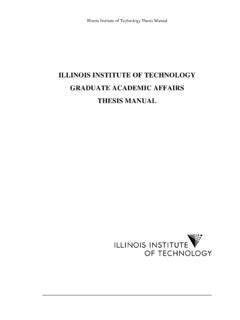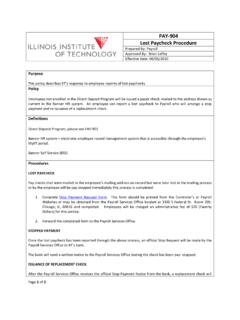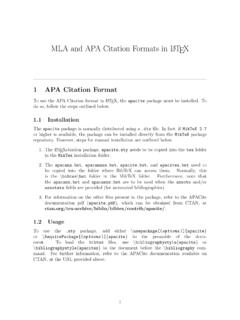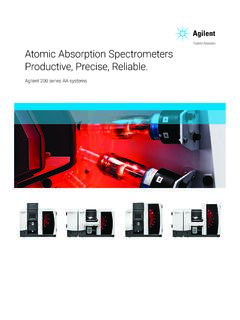Transcription of Academic Resource Center - Illinois Institute of Technology
1 Creep Deformation in Materials Academic Resource Center Agenda Define creep and discuss its importance in materials engineering. Identify the primary mechanisms of creep deformation. Creep model parameters. Detail experimental ways to determine creep. Discuss design options to minimize creep deformation. Useful concepts 000 strain gEngineerin stress gEngineerinlllAF )ln()ln( strain True stress True'00'''0 AAllldlAFlltt Creep It is a time- dependent deformation under a certain applied load. Generally occurs at high temperature (thermal creep), but can also happen at room temperature in certain materials ( lead or glass), albeit much slower.
2 As a result, the material undergoes a time dependent increase in length, which could be dangerous while in service. Classical Creep Curve The rate of deformation is called the creep rate. It is the slope of the line in a Creep Strain vs. Time curve. Creep Stages Primary Creep: starts at a rapid rate and slows with time. Secondary Creep: has a relatively uniform rate. Tertiary Creep: has an accelerated creep rate and terminates when the material breaks or ruptures. It is associated with both necking and formation of grain boundary voids.
3 Effect of Temperature & Stress Effect of Individual Variable Characteristics of Creep Creep in service is usually affected by changing conditions of loading and temperature The number of possible stress-temperature-time combinations is infinite. The creep mechanisms is often different between metals, plastics , rubber, concrete. Creep Mechanisms Bulk Diffusion (Nabarro-Herring creep) Creep rate decreases as grain size increases Grain Boundary Diffusion (Coble creep) Stronger grain size dependence than Nabarro Herring Dislocation climb/creep Controlled by movement of dislocations, strong dependence on applied stress.
4 Thermally activated glide Occurs in polymers and other viscoelastic materials Creep Test Measures dimensional changes accurately at constant high temperature and constant load or stress. Useful for modeling long term applications which are strain limited. Provides prediction of life expectancy before service. This is important for example turbine blades. Creep Test cont d Measures strain vs. time at constant T and Load (Similar to graph seen previously). Relatively low loads and creep rate Long duration 2000 to 10,000 hours. Not always fracture.
5 Strain typically less than Creep Test cont d Creep generally occurs at elevated temperatures, so it is common for this type of testing to be performed with an environmental chamber for precise heating/cooling control. Temperature control is critical to minimize the effects of thermal expansion on the sample. Creep Test: General Procedure The unloaded specimen is first heated to the required T and the gage length is measured. The predetermined load is applied quickly without shock. Measurement of the extension are observed at frequent interval.
6 Average of about 50 readings should be taken. Creep Test Apparatus Creep Parameters To predict the stress and time for long lives on the basis of much shorter data. Plant life 30 to 40 years Creep data is usually not available beyond lives of more than 30000 hrs. Larson Miller Parameter and other material specific models are used. Larson Miller Parameter Model based on Arrhenius rate equation. LMP= T(C+log tr) Where T = temperature (K or R) tr = time before failure (hours) C= material specific constant Predicts rupture lives given certain temperature and stress.
7 First used by General Electric in the 50 s to perform research on turbine blades. Stress Rupture Tests Determines the time necessary for material to result in failure under a overload. Useful in materials selection where dimensional tolerances are acceptable, but rupture cannot be tolerated. Generally performed at elevated temperatures. Smooth, notched, flat specimens or samples of any combination can be tested. Creep vs. Stress Rupture Test Design Considerations to avoid Creep Reduce the effect of grain boundaries: Use single crystal material with large grains.
8 Addition of solid solutions to eliminate vacancies. Employ materials of high melting temperatures. Consult Creep Test Data during materials Selection Type of service application Set adequate inspection intervals according to life expectancy. References Abbaschian, Reed-Hill. Physical Metallurgy Principles . 4th edition. 2009 Dowling, Norman E. Mechanical Behavior of edition. 2007 Larson Miller Parameter













